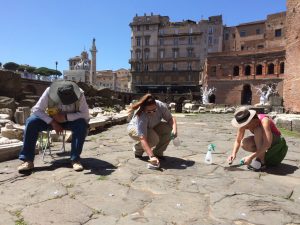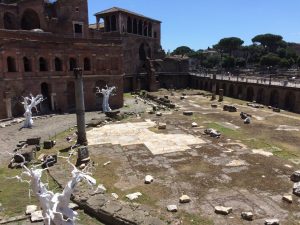A team of postgraduates are collecting new data in the Markets of Trajan adjacent to the Imperial Forum built by Trajan in the second century AD.
The data is collected with a portable Xray Flouresence (pXRF) analyser. This provides indications of the geo-chemical composition of paving stones from the site. In turn, this will allow researchers at the University of Kent to establish from which lava flow the stone was quarried. The machine is placed on each paving-stone for 90 seconds without any damage or destruction to the material.
Two PhD students taking part in this work, Julia Peters and Catherine Hoggarth, studied for their MAs in Rome, whilst Tabitha Rose is currently taking the MA. They will be working alongside a geologist, Mike Worthing and Lloyd Bosworth – the Department’s Archaeology Technician.
The project is led by Professor Ray Laurence and informs his research on Roman roads in Italy. His previous publications on this topic include The Roads of Roman Italy: Mobility and Cultural Change.
Professor Laurence commented: This work will provide us with new insights into the pattern of supply of stone for paving the streets of Rome. The team has worked hard to calibrate the equipment to replicate in the field, what might only be achieved in a large laboratory or via the destruction of archaeological materials. pXRF is a neat solution to provide a lot of data quickly using a small team.


